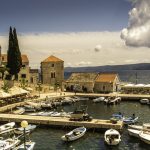![]() East Europe Part One: Croatia, Montenegro and Bosnia-Herzegovina
East Europe Part One: Croatia, Montenegro and Bosnia-Herzegovina
Story and Photos by Ashok Khanna.
Like most people, I was feeling cooped up in the US after the pandemic, especially with the near-daily devastating news of mass shootings and vitriolic discordant politics. But I couldn’t leave until my new passport arrived. When it did, I scoured the Overseas Adventure Travel (OAT) website for the first available spot for a single traveler to an interesting destination. I almost never travel with a tour company, but with the Covid virus still prevalent, I thought it would be safer as the company may have arrangements to help me if I got sick. A couple of people had suggested OAT because it catered to small groups and did not levy a supplement for a single traveler. The “Crossroads of the Adriatic” came up as the most interesting tour, with an opening in mid-June for travels through Croatia, Montenegro, Bosnia-Herzegovina, Slovenia, and Hungary.
From Trieste to Pula Along the Coast of Vanished Empires
![]() Story and Photos by Libor Pospisil.
Story and Photos by Libor Pospisil.
The Adriatic is the closest sea to the heart of Europe. But its waters stop at the foothills of the Alps. The countries on the other side of the mountains remain separated from the sea forever. They can only watch with envy how the Italian northeast, Slovenia, and Croatia enjoy the beaches and the culture that came with its prosperous Adriatic history. It was not always this way. Until the First World War, the landlocked peoples and their coastal neighbors lived in the same big polity, “the great and mighty empire” of Austria-Hungary, in the words of Stefan Zweig. This empire was peculiar. in that it was terrestrial, multinational, and sleepy. It could not compete with the naval powers of its time. It kept trying, however. It anxiously hung on to the fragment of the coast it had—the province of Austrian Littoral, which reached from Trieste in present-day Italy all the way to Pula, at the tip of the Istrian peninsula in Croatia.
Brac Island. Croatia: Sun, Sea and Stone
 Story and Photos by Lee Daley. In Croatia, aboard the Katarina Line Futura: As we watched deckside, our small cruise ship anchored alongside the Dalmatian Coast shore of Brac Island and its Golden Horn Beach, known as one of Europe’s most beautiful. Holding just 38 passengers, the Futura’s compact size fits into ports large ships can’t handle. Our eager group of sunbathers easily disembarked and clambered aboard small boats for the short ride to the coast line’s golden sands. Once ashore, my companion and I decided to meander. Sunbathing could come later.
Story and Photos by Lee Daley. In Croatia, aboard the Katarina Line Futura: As we watched deckside, our small cruise ship anchored alongside the Dalmatian Coast shore of Brac Island and its Golden Horn Beach, known as one of Europe’s most beautiful. Holding just 38 passengers, the Futura’s compact size fits into ports large ships can’t handle. Our eager group of sunbathers easily disembarked and clambered aboard small boats for the short ride to the coast line’s golden sands. Once ashore, my companion and I decided to meander. Sunbathing could come later.
Croatian Wine Tasting in the Dalmatian Islands
![]() Story and Photos by John Sundsmo.
Story and Photos by John Sundsmo.
On a recent Katarina Line cruise of Croatian discovery, we learned that wine makers in the Dalmatian Islands have left an indelible mark on the fine wines produced in California, Australia, New Zealand and Chile. Remarkably, throughout wars, conquest and droughts, the islands of the Adriatic Sea, (East of Italy and South of the Alps), have produced fine wines for 2,500 years. Galleys and sailing ships transported that wine up and down the Mediterranean throughout Greek (500BC) and Roman times well into the 14th century. Greek writer Athenaeus wrote 18 centuries ago about the high quality of Croatian wine especially those coming from the islands of Hvar and Korčula.
Leave a Reply